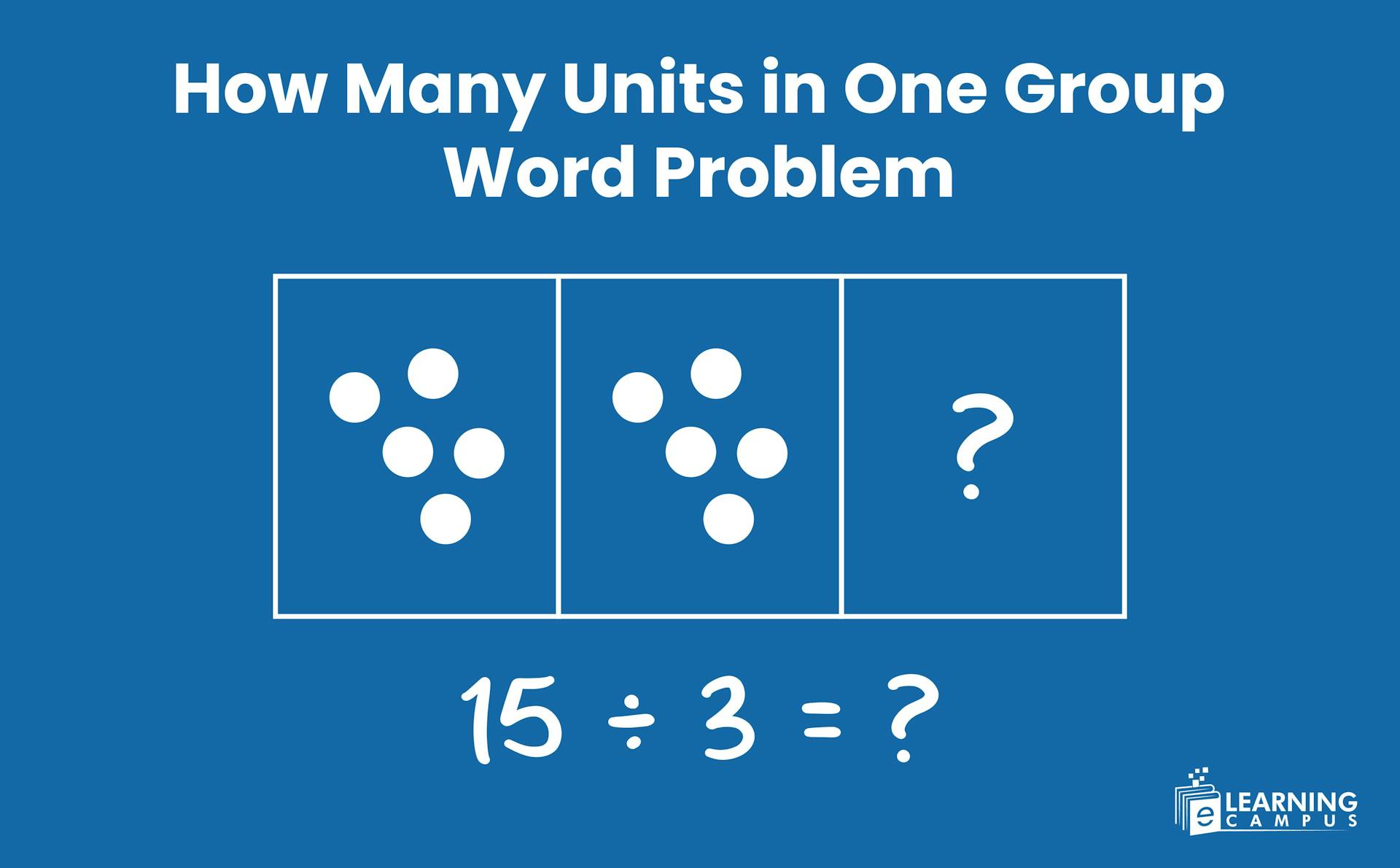How Many Units in One Group” Word Problem

Are you confused about ‘how many units in one group’ word problems, and don’t know how to solve them? It is a challenge for every student. To solve these problems, you need to divide the total quantity by the number of groups to find the amount in each group.
If you are struggling with ‘units in group problems’, this guide is for you. In this blog, we will explain everything you need to know about "how many units in one group" word problems, provide clear explanations of how these problems work, and offer step-by-step solving strategies with practical examples.
What Are "Units in One Group" Problems?
The ‘units in one group’ problems are division-based scenarios where we know the total amount and the number of equal groups, and we need to find out how many items belong in each group.
Simply, these problems ask how many items (units) are in a single, equally sized group when a total amount is divided among a known number of groups.
How to Solve Units in Group Word Problems
Solving units in group word problems involves the partitive division model. In this method, we divide a total quantity into a known number of equal groups to find the size of each group.
Steps to Solve Unit-Based Word Problems
Read and Understand the Problem
Carefully read the word problem to understand what is being asked and what information is given.
Identify the Total Quantity
Look for the total number of items or units in the problem. This could be things like candies, dollars, or hours.
Determine the Number of Groups
Find how many groups the total quantity is being divided into. This could be people, boxes, or time periods.
Set Up the Division
The question "how many units in one group" usually translates to dividing the total quantity by the number of groups.
The formula to solve units in a group word problem is given as;
Perform the Calculation
Use division to compute the answer. Decide if the problem calls for a whole number (e.g., you can’t split a candy) or allows for decimals (e.g., hours or money).
Check for Remainders
If the division does not result in a whole number, consider whether the problem asks for a remainder or if you should round the answer based on context.
Verify the Context
Ensure the answer makes sense in the problem’s scenario. For example, if it is about people or objects, a fractional answer might need adjustment.
Write a Clear Answer
State the number of units per group, using proper units, such as candies per person, dollars per group.
Solved Examples of “How Many Units in One Group” Word Problems
Solving these problems develops logical thinking, understanding fairness, and helps solve real-world challenges. Students who confidently tackle ‘units per group’ problems build a strong foundation for more advanced concepts.
Here we provide you with some solved examples of word problems.
Example 1
Problem: Anna has 24 candies to share equally among 6 friends. How many candies does each friend get?
In this problem, we have to find how many candies (unit) will every friend get among 6 friends (group), if the total candies is 24.
The solution involves the following steps.
- Step 1: Total quantity = 24 candies.
- Step 2: Number of groups = 6 friends.
- Step 3: Set up division: 24÷6
- Step 4: Calculate: 24÷6=4
- Step 5: No remainder, as 24 divides evenly.
Each friend gets 4 candies. It means each friend gets four units in a group of six friends.
Example with Remainder
Problem: A baker has 20 muffins to pack into 3 boxes equally. How many muffins go in each box?
- Step 1: Total quantity = 20 muffins.
- Step 2: Number of groups = 3 boxes.
- Step 3: Set up division: 20÷3
- Step 4: Calculate: 20÷3 = 6.2
- Step 5: Remainder is 2. It means 2 muffins are left over.
- Step 6: Each box gets 6 muffins, and 2 muffins remain unpackaged.
How Many Units in One Group Fraction Division Word Problem
In a fraction division word problem of ‘units in one group’, we determine the number of units in a complete group.
Steps to solve fraction division problems
- Set up the division: The problem is set up as (total units) ÷ (fraction of a group) = (units in one group).
- Use the reciprocal: To solve, we multiply the total units by the reciprocal of the fraction of the group.
- Calculate the result: Multiply the numerators and the denominators.
- Interpret the answer: The result tells the number of units in one complete group.
Example
For example, if the problem involves 1/3 divided by 1/8. We can find the units in a whole group.
We will solve this problem step by step.
We will divide the fraction by multiplying its inverse.
- 3/5 divided by 3/2
- 3/5 divided by 1/6
Word Problems Involving How Many Units in One Group
Example
Write two word problems for 35÷5=?, one for the "how-many-units-in-1-group" interpretation of division and one for the "how-many-groups" interpretation of division.
Here are two word problems for 35÷5=? that illustrate the two main interpretations of division.
How many units in 1 group (Partitive) interpretation
- Problem: You have 35 strawberries to share equally among 5 friends. How many strawberries does each friend get?
- Explanation: We know the total amount (35) and the number of groups (5). We need to find the number of units (strawberries) that go into each group.
We will divide 35 by 5.
The answer is 7 strawberries per friend.
How many groups (Quotative) interpretation
- Problem: A gardener has 35 tomato seedlings. He wants to plant them in rows with 5 seedlings in each row. How many rows can he plant?
- Explanation: This model is also known as the "measurement" or "repeated subtraction" model. It involves finding the number of groups. We know the total amount (35) and the size of each group (5). We can determine how many groups can be made.
To solve this, we will divide the total amount by the size of each group.
The answer is 7 rows.
Example
Write a simple how many units in 1 group word problem for 17/5 for which the answer ‘3, remainder 2’ is appropriate. Explain what the answer ‘3, remainder 2’ means in the context of the problem.
Solution
We can understand the problem as;
A teacher has 17 pencils to distribute into small pencil cases, with each case holding 5 pencils. How many full pencil cases can she fill, and how many pencils will be left over?
The answer "3, remainder 2" means she can fill 3 pencil cases, with 2 pencils remaining, which are not enough to fill another case.
Conclusion
A "how many units in one group" word problem involves division, where a total number of items is divided into a specified number of equal groups, and the goal is to find the quantity of items in each of those groups. For example, if 12 slices of pizza are divided among 4 friends, the problem asks "how many slices does each friend get?" and is solved by 12 ÷ 4 = 3, meaning each friend receives 3 slices.
Get an Expert Math Online Tutor
Do you want to master mathematical concepts and excel in your subject? Join us now. We have expert online math tutors to help you with math. You will get personalized instruction and easy tips for exam preparation.
